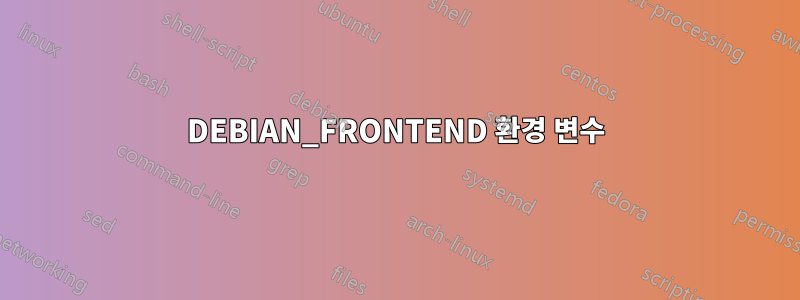
나의 잠재적인 호스팅 제공업체제안KVM 기반 서버의 OS 이미지를 최소화하기 위해 터미널에서 명령을 실행합니다. KVM 템플릿에는 필요하지 않은 패키지가 포함되어 있으므로 동일한 명령을 사용하여 원하지 않는 패키지를 제거할 수 있을 것이라고 생각했습니다.
해당 명령은 로 시작 DEBIAN_FRONTEND=noninteractive하고 apt-get remove다음과 같이 호출됩니다.
DEBIAN_FRONTEND=noninteractive apt-get remove --purge -y -o Dpkg::Options::="--force-confdef" -o Dpkg::Options::="--force-confold" package-1 package-2 ... package-n; apt-get -y autoremove; apt-get clean all
환경변수를 처음 접하는데 DEBIAN_FRONTEND아직까지는 유용한 정보를 찾을 수 없었습니다. 그래서 무엇을 설정하는지 noninteractive, 그리고 권장되는 경우 해당 값( noninteractive)이 지속될 것이라고 가정하기 때문에 궁금합니다.
답변1
명령 앞에 단순히 apt명령을 추가하는 것은 DEBIAN_FRONTEND=something해당 명령이 적용된 단일 명령 이후에는 지속되지 않습니다.
옵션 DEBIAN_FRONTEND은 의 섹션 7 매뉴얼 페이지에 설명되어 있습니다 ( 시스템에서 이러한 옵션을 사용하려면 패키지를 debconf설치해야 할 수도 있습니다 ). debconf-doc에서 man 7 debconf:
Frontends
One of debconf's unique features is that the interface it presents to
you is only one of many, that can be swapped in at will. There are many
debconf frontends available:
dialog The default frontend, this uses the whiptail(1) or dialog(1)
programs to display questions to you. It works in text mode.
readline
The most traditional frontend, this looks quite similar to how
Debian configuration always has been: a series of questions,
printed out at the console using plain text, and prompts done
using the readline library. It even supports tab completion. The
libterm-readline-gnu-perl package is strongly recommended if you
chose to use this frontend; the default readline module does not
support prompting with default values. At the minimum, you'll
need the perl-modules package installed to use this frontend.
This frontend has some special hotkeys. Pageup (or ctrl-u) will
go back to the previous question (if that is supported by the
package that is using debconf), and pagedown (or ctrl-v) will
skip forward to the next question.
This is the best frontend for remote admin work over a slow con‐
nection, or for those who are comfortable with unix.
noninteractive
This is the anti-frontend. It never interacts with you at all,
and makes the default answers be used for all questions. It
might mail error messages to root, but that's it; otherwise it
is completely silent and unobtrusive, a perfect frontend for
automatic installs. If you are using this front-end, and require
non-default answers to questions, you will need to preseed the
debconf database; see the section below on Unattended Package
Installation for more details.
또한 다음과 같이 언급합니다.
You can change the default frontend debconf uses by reconfiguring deb‐
conf. On the other hand, if you just want to change the frontend for a
minute, you can set the DEBIAN_FRONTEND environment variable to the
name of the frontend to use. For example:
DEBIAN_FRONTEND=readline apt-get install slrn
The dpkg-reconfigure(8) and dpkg-preconfigure(8) commands also let you
pass --frontend= to them, followed by the frontend you want them to
use.
Note that not all frontends will work in all circumstances. If a fron‐
tend fails to start up for some reason, debconf will print out a mes‐
sage explaining why, and fall back to the next-most similar frontend.



